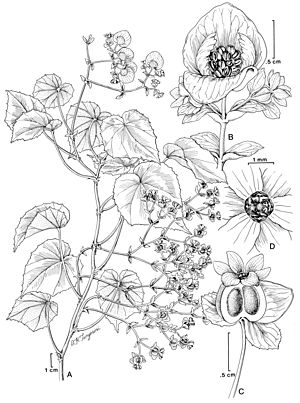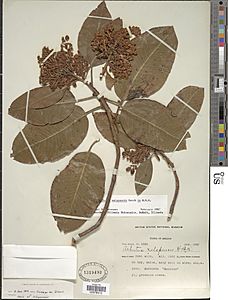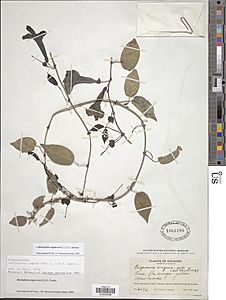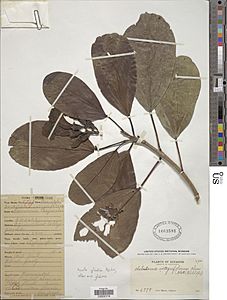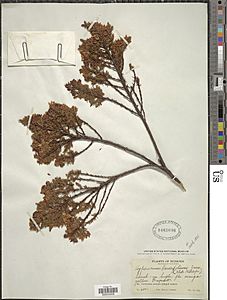Ynes Mexia facts for kids
Quick facts for kids
Ynés Enriquetta Julietta Mexía
|
|
|---|---|
| Ynés Mexía | |
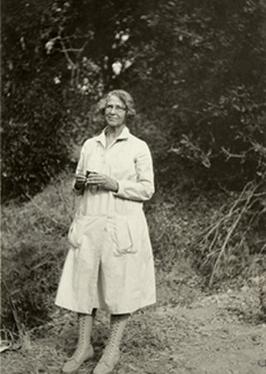 |
|
| Born | May 24, 1870 Washington, D.C., United States
|
| Died | July 12, 1938 (aged 68) Berkeley, California, United States
|
| Nationality | Mexican, American |
| Citizenship | United States Mexico |
| Alma mater | University of California, Berkeley |
| Awards | Life member of the California Academy of Sciences |
| Scientific career | |
| Fields | Botany |
| Author abbrev. (botany) | Mexia |
Ynés Enriquetta Julietta Mexía (May 24, 1870 – July 12, 1938) was a brave and important Mexican-American botanist. She was famous for collecting many new types of plants. She found these plants in places like Colombia, Mexico, and Peru.
Ynés Mexía even discovered a new group of plants called Mexianthus. During her 16-year career, she collected over 150,000 plant samples for scientists to study. She faced many dangers in her research, including poisonous plants, tough landscapes, and even earthquakes.
Contents
Who Was Ynés Mexía?
Early Life and Family Background
Ynés Mexía was born on May 24, 1870, in Washington, D.C. Her father, Enrique Mexia, was a diplomat from Mexico. Her mother was Sarah Wilmer Mexía. Ynés's grandfather, José Antonio Mexía, was a well-known general in Mexico.
In 1873, her father went back to Mexico. Ynés's mother then moved Ynés and her six half-siblings to a ranch in Limestone, Texas. This area was later named Mexia. The family then moved to different cities in the eastern United States and Canada. Ynés went to private schools. She later attended St. Joseph's Preparatory School in Emmittsburg. In 1887, she moved to Mexico and lived with her father for ten years.
Life Changes and New Interests
In 1897, Ynés married Herman de Laue, a Spanish-German merchant. He passed away in 1904. After his death, Ynés started a business raising pets and poultry. She used land she inherited from her father. Later, she married D. Augustin Reygados, but their marriage ended in 1906.
Around 1909, when she was 39, Ynés became unwell. She moved to San Francisco to get medical help. She was treated for about ten years. While living in Northern California, Ynés started going on trips with the Sierra Club. They explored the mountains. This is where she became very interested in nature, like redwood trees, birds, and plants.
Starting a Career in Botany
Ynés decided to study at the University of California, Berkeley. There, she learned about botany, which is the study of plants. She went on her first plant-collecting trip in 1925. She wrote to another botanist, Alice Eastwood, saying she was going to Mexico. This was her first time exploring plants in that country. Ynés found her true calling in life. She wrote that she had a job where she could "produce something real and lasting."
Over the next 13 years, Ynés Mexía traveled far and wide. She went from Alaska in the north all the way to the southern tip of South America. People she met were often surprised by her actions. She did not act like a typical woman of the early 1900s. She traveled alone, rode horses, and wore pants. She even preferred to sleep outdoors, even if beds were available.
Ynés wrote about breaking these old ideas. She said, "A well-known collector and explorer stated very positively that 'it was impossible for a woman to travel alone in Latin America.'" She proved them wrong. She decided that if she wanted to know South America better, the best way was to travel right across it.
In 1938, Ynés became sick during a trip to Oaxaca, Mexico. She had to stop her journey and return to the United States. Doctors found she had lung cancer. She passed away a month later at age 68. William Edward Colby, who worked for the Sierra Club, said Ynés had a "friendly unassuming spirit" and "rare courage." This courage allowed her to travel alone in places few others would dare to go.
Ynés Mexía's Amazing Career
Ynés Mexía began her botany career in 1922. She joined an expedition with Mr. E. L. Furlong from the University of California, Berkeley. Her big successes started in 1925. She went on a two-month trip to western Mexico with Roxanna Ferris, a botanist from Stanford University. During this trip, Ynés fell off a cliff. She broke some ribs and hurt her hand. Even though the trip stopped early, she still collected 500 plant samples. Several of these were new species!
The first plant named after her was Mimosa mexiae. It was found on this trip and named by Joseph Nelson Rose. Many other plants she discovered were also named in her honor. One example is a daisy-like plant called Zexmenia mexiae, now known as Lasianthaea macrocephala. In December 1926, she found the first sample of Mexianthus near Puerto Vallarta.
Expeditions and Discoveries
In 1928, Ynés was hired to collect plants in Mount McKinley National Park in Alaska. There, she gathered 6,100 plant samples. The next year, she went to South America. She traveled by canoe down the Amazon River for 4,800 kilometers (about 3,000 miles). This journey ended at the river's source in the Andes mountains. This amazing trip resulted in 65,000 plant samples!
During her Amazon expedition, she lived for three months with the Araguarunas, a native group. Another botanist, Mary Agnes Chase, joined her for a short time. In Ecuador, Ynés worked with the Department of Agriculture. She focused on cinchona (a type of tree) and special herbs that help hold soil in place.
John Thomas Howell, another botanist, called Ynés Mexía a "close friend" of Alice Eastwood. In 1933, Ynés joined Miss Eastwood and Mr. Howell on a collecting trip. They traveled through Nevada, Utah, Arizona, and California in an open Model T Ford. They collected over 1,300 plant samples. Mr. Howell said Ynés was a "dear good friend."
Ynés Mexía's research and trips were paid for by selling her collected plant samples. She sold them to science institutions and private collectors.
Sharing Her Adventures
Ynés often wrote about her trips. Her stories appeared regularly in The Gull, a newsletter from the Audubon Society of the Pacific. The Sierra Club Bulletin also published two articles about her travels: "Three Thousand Miles up the Amazon" (1933) and "Camping on the Equator" (1937). More articles were published in Madrono, a journal for plant scientists.
Ynés was an active member of many science groups. These included the California Botanical Society, the Sierra Club, and the California Academy of Sciences. She also gave talks to groups in the San Francisco Bay Area. People loved her exciting stories and the great photos she took.
Her collected plant samples are kept in many important places. These include the California Academy of Sciences, the New York Botanical Garden, and the Smithsonian Institution. Her personal papers are saved at the California Academy of Sciences and the Bancroft Library in California.
Ynés Mexía's Lasting Impact
- Example specimens collected by Ynés Mexía
Ynés Mexía was very unusual for a botanist of her time. She was a woman, a person of Mexican heritage, and she started her career later in life, in her mid-fifties. Vassiliki Betty Smocovitis, a professor who studies the history of science, explained why this was special. She said that women were often told not to do this kind of work because it was seen as "unfeminine and dangerous." It involved camping out and living a rough life. But Ynés Mexía was determined. She did exactly the work she wanted to do.
Ynés was a lifetime member of the California Academy of Sciences. In 1932, she published a book called Brazilian Ferns Collected by Ynés Mexía with Edwin Bingham Copeland.
Even though Ynés had a short career of only 13 years, she collected a huge number of plant samples. The British Natural History Museum says she collected at least 145,000 plant specimens. About 500 of these were new species! Two new groups of plants, Mexianthus mexicanus and Spumula quadrifida, were named because of her work. On her very first trip, she collected 500 samples. This is the same number of samples that Charles Darwin collected on his famous voyage on the Beagle! So far, 50 new species have been named after her.
Her colleagues remember Ynés Mexía for her amazing skills in the field. She was tough and brave in difficult and dangerous places. She was also known for her careful and exact work as a plant collector.
Other researchers benefited from her knowledge of Central and South American cultures and nature. She also spoke Spanish very well. Thomas Harper Goodspeed, a botanist, traveled with Ynés to the Andes mountains. He said her advice and information about life in the Andes were "invaluable."
Ynés Mexía left a large part of her money to the Sierra Club and the Save the Redwoods League. She wanted to help protect the environment. She also gave money to Vernon Orlando Bailey. This helped him create more humane traps for animals.
Recognitions and Tributes
- Google Doodle: Ynés Mexía was honored with a Google Doodle on September 15, 2019.
- PBS Short Documentary: In 2020, a short film about Ynés Mexía's life was part of the Unladylike2020 series by WNET for PBS.
Publications by Ynés Mexía
- Botanical Trails in Old Mexico (1929)
- Plant lists, Brazil, Mexico, and South America (1930)
- Brazilian ferns collected by Ynes Mexia (with Edwin Bingham Copeland) (1932)
- Three Thousand Miles up the Amazon (1933)
- Mrs. Ynes Mexiás Route in Ecuador, 1934–1935 (1936)
- Camping on the Equator (1937)
See also
 In Spanish: Ynes Mexia para niños
In Spanish: Ynes Mexia para niños
- Timeline of women in science
- Botanists


